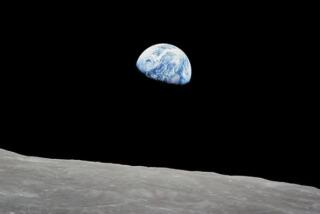Chilean quake shortened Earth’s day, but not by much
- Share via
When a magnitude 8.8 earthquake struck South America last weekend, the ground rumbled in Chile, the sea rose in the Pacific, and a day on Earth got shorter. Not by much.
Earthlings ended up losing 1.26 millionth of a second of a day. You can’t sense it. Nor can your dog -- the one you insist senses approaching earthquakes -- feel it.
But while other experts charted the shift of tectonic plates and the swell of ocean waters wrought by the quake, geophysicist Richard Gross mathematically calculated the temblor’s disruption of the day.
The thrust quake -- in which plates underground move vertically -- caused mass to move everywhere, said Gross, who works at the Jet Propulsion Laboratory in La Cañada Flintridge.
“On average, the mass of the Earth got a bit closer to the rotation axis,” he said. As a result, Gross said, the planet rotates faster -- “just like a spinning skater brings her arms in closer to her body to rotate faster.” When the planet rotates faster, the day shortens, he said.
Gross studies the Earth’s rotation and how it is affected by cataclysmic forces of nature. “Anything that moves mass around on the Earth I take a look at,” he said.
And it takes a mega-earthquake to attract Gross’ attention. The magnitude 6.7 Northridge earthquake didn’t even register on the scale of throwing off the Earth’s rotation.
“I didn’t look at that earthquake,” he said. “It takes something like the Chilean or Indonesian earthquake before I look at it.”
This earthquake also shifted the axis around which the Earth rotates, Gross said.
Although the Chilean quake shortened the day by 1.26 microseconds -- the unit of time for millionths of a second -- the 2004 Indian Ocean earthquake that triggered the catastrophic Asian tsunami shaved 7 microseconds off the day, according to Gross’ calculations.
Will our biological sleep clocks notice? Circadian rhythms can be affected by even a shift in minutes, said Michael Terman, director of the Center for Light Treatment and Biological Rhythms at Columbia University Medical Center.
“Circadian biology . . . is indeed sensitive to the Earth’s rotation, but a change of 1.26 microseconds won’t have significant impact -- I hope!” Terman said.
Of course, losing just 1.26 microseconds a day takes a couple of millenniums to add up to one single second of lost time. (2,174 years to be more precise.) Gross suggests it’s not worth tallying that way.
“It takes a lot of these big earthquakes to add up to even a second,” he said. “The bigger changes are in the liquid core within the Earth.”
Those changes can throw off a day by a whopping three or four milliseconds, he said. “Those are the things that cause us to have a leap second every year or so,” he said.
Winds and ocean currents are other forces plying the Earth, changing its shape and the length of its day, Gross said.
Far from evoking that textbook illustration of a smooth round ball of continents and blue oceans, Gross describes Earth as a planet of unevenly distributed mass wobbling as it rotates around its imperfectly balanced axis, its physique woefully pear-shaped. “It’s a bit fatter south of the Equator,” Gross said.
“The Earth is not completely elastic. It’s kind of like putty,” he said. “If you have a sudden shock to it, it will continue to deform later in response to that shock.”
More to Read
Sign up for Essential California
The most important California stories and recommendations in your inbox every morning.
You may occasionally receive promotional content from the Los Angeles Times.











